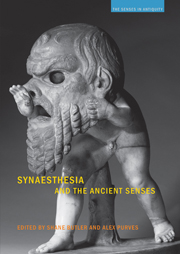Book contents
- Frontmatter
- Contents
- Contributors
- Introduction: synaesthesia and the ancient senses
- 1 Why are there nine Muses?
- 2 Haptic Herodotus
- 3 The understanding ear: synaesthesia, paraesthesia and talking animals
- 4 Aristophanes, Cratinus and the smell of comedy
- 5 “Looking mustard”: Greek popular epistemology and the meaning of δριμύς
- 6 Plato, beauty and “philosophical synaesthesia”
- 7 Manilius' cosmos of the senses
- 8 Reading death and the senses in Lucan and Lucretius
- 9 Colour as synaesthetic experience in antiquity
- 10 Blinded by th light: oratorical clarity and poetic obscurity in Quintilian
- 11 The sense of a poem: Ovids Banquet of Sence (1595)
- 12 Saussure's anaphonie: sounds asunder
- 13 Beyond Narcissus
- Bibliography
- Index
Introduction: synaesthesia and the ancient senses
- Frontmatter
- Contents
- Contributors
- Introduction: synaesthesia and the ancient senses
- 1 Why are there nine Muses?
- 2 Haptic Herodotus
- 3 The understanding ear: synaesthesia, paraesthesia and talking animals
- 4 Aristophanes, Cratinus and the smell of comedy
- 5 “Looking mustard”: Greek popular epistemology and the meaning of δριμύς
- 6 Plato, beauty and “philosophical synaesthesia”
- 7 Manilius' cosmos of the senses
- 8 Reading death and the senses in Lucan and Lucretius
- 9 Colour as synaesthetic experience in antiquity
- 10 Blinded by th light: oratorical clarity and poetic obscurity in Quintilian
- 11 The sense of a poem: Ovids Banquet of Sence (1595)
- 12 Saussure's anaphonie: sounds asunder
- 13 Beyond Narcissus
- Bibliography
- Index
Summary
Synaesthesia is best known as the name of the condition of those individuals who regularly experience one kind of sensory stimulus simultaneously as another – and who almost universally regard their atypical kind of perception as a gift rather than an affliction. The commonest variety of synaesthesia associates particular sounds with particular colours, a phenomenon that is itself best known by the French term audition colorée. Roughly contemporary, however, with modern interest in this clinical phenomenon has been the broader application of synaesthesia to the sensory blending experienced by all readers, synaesthetes or not. This happens through literature's “use of metaphors in which terms relating to one kind of sense-impression are used to describe sense-impressions of other kinds”, as the Oxford English Dictionary puts it, providing an example of this usage from W. B. Stanford's Greek Metaphor (1936), which introduced the term to many classicists in a discussion “On Synaesthesia or Intersensal Metaphor”.
Interest in both kinds of synaesthesia has its roots in the seventeenth and eighteenth centuries, which saw an explosion of philosophical and scientific enquiry into the nature of sensation, cognition and aesthetic pleasure. The very term aesthetic in its modern meaning first appeared in this period, applied by the philosopher Alexander Baumgarten to our sensual experience of a work of art, something which, he argued, both preceded and transcended our mental or “noetic” appreciation of the same. Etymologically, synaesthesia and aesthetic(s) alike can be traced back much farther, to the Greek verb for experience, aisthanomai, and its cognates and compounds.
- Type
- Chapter
- Information
- Synaesthesia and the Ancient Senses , pp. 1 - 8Publisher: Acumen PublishingPrint publication year: 2013



